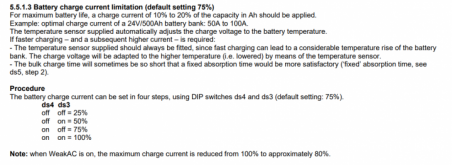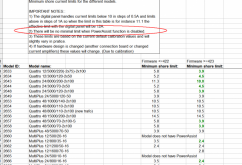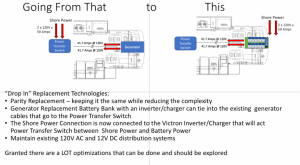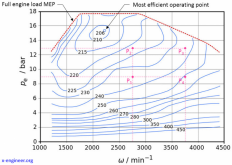Sincerely and respectfully, I do appreciate you feedback and I am enjoying the conversation.. So many times threads do not maintain decorum. I learn a lot through these exchanges and the thoughtful discourse improves my thinking and design. In my day job, I am a Technical Fellow and one of my key roles is to teach and encourage junior engineers how to think and problem solve and to accept challenges without being defensive.
My Onan 10K consumes about 3 gallons per hour and will NOT operate below a ¼ tank (33 gallons) – this can be a bummer and have to plan to be full before stopping for any period of time. Many times in my rig I am “sprinting” 600+ miles/day to the East Coast from Denver and often stop at “no services” pull-offs. As long as I fill up before stopping, running the generator all night is not an issue (mostly because I am sandwiched between a bunch of semis that run their diesels all night). But when I boondock or state camp – I do get a LOT of other camper scowling and coming over to remind me of the gen rules (I strictly comply and keep the rules at hand – many time they do not pay as much attention to them as I do myself – this happened 3 times last year) My rig is almost all electric, except for forced air heat and hot water so it is significantly dependent and AC power. So, I do have to run the gen a significant amount of time when in living in the rig – induction cooktop, TVs, AC/Heat pumps, washer/dryer – there is no lite impact camping (I have two kids 2 and under – LOL) and two dogs so the AC has to be set to run during the day when we don’t take them on the day trips..
There is a price to pay for servicing and maintaining another diesel powerplant on the rig but in contrast with the battery approach that should be pretty maintenance free – just managed.
So, what I am trying to say, the diesel gen does need to be managed and it is not “free”.
My Cummings 380 is provides plenty of power/torque to make through the CO passes at a respectfully 50 mph+ fully loaded with water(100g) fuel (100g) for about total of 1500lbs and flat towing a Jeep. While I would enjoy a bigger engine, I do not want a bigger rig, 40 feet is perfect me. On the average, I get about 7.5 gal per hour at 2200 RPM. I have not carefully monitored the consumption at idle (don’t remember idle rpm). But when driving the rig, I start it the morning and leaving it running all day till I stop, never turning it off.. BTW – this keeps the 12V battery bank fully charged of off the stock alternator.
I plan to be able to control how the 12V subsystem gets charged by adding the necessary software control relays to avoid what I call ping-pong charging between the 12V subsystem and the 48V subsystem. You are correct that this is very wasteful and should be avoided.
https://www.americanpowerinc.com/high-output-alternators/
At 48-56V they can run steady state producing 160 Amp or around 8600 Watts of power
This is what you don’t want to do……
So you need something like this:
http://wakespeed.com/products.html
You are very correct in your statement about including solar natively, I have come to that same conclusion. Looking at my old math, of I baseline just trying to run the three ACs at 1725 Watts each on solar, I need a minimum of 5K watts of solar.. This is my homework now, to design the solar subsystem..
In my day job, I am very much a student of Moore’s Law and Ahmdel’s Law.. Not at all arguing the asymptotically nature of the curves. However, over the last year or so I have seen a 20-30% increase in power density of Li batteries (both Tesla and Battleborn). I would have to guess they are running on a 30-50% costs of goods and think competition and advancements in manufacturing will erode some of their margin and reduce the consumer price. And there are disruptive new technologies that might mature, like Lithium Titanate Cells and Batteries – lighter and faster to charge_
One of the biggest logistic camping problems that I have is that I have to store my RV off of my property without power. Unloading and loading the refrigerator is the biggest pain in our RVing. Of course, with this system I can easily maintain the temp refrigerator between trips.
I run a Peplink (4G & WiFi router) device in the RV and can access it remotely and since the over-all solution will be software controlled (mostly by Victron) I should be able to dial in all the charging, storage and consumption almost anywhere..
Regarding the price of my science project – Shhh don’t tell the wife ;D
Happy Sunday…








